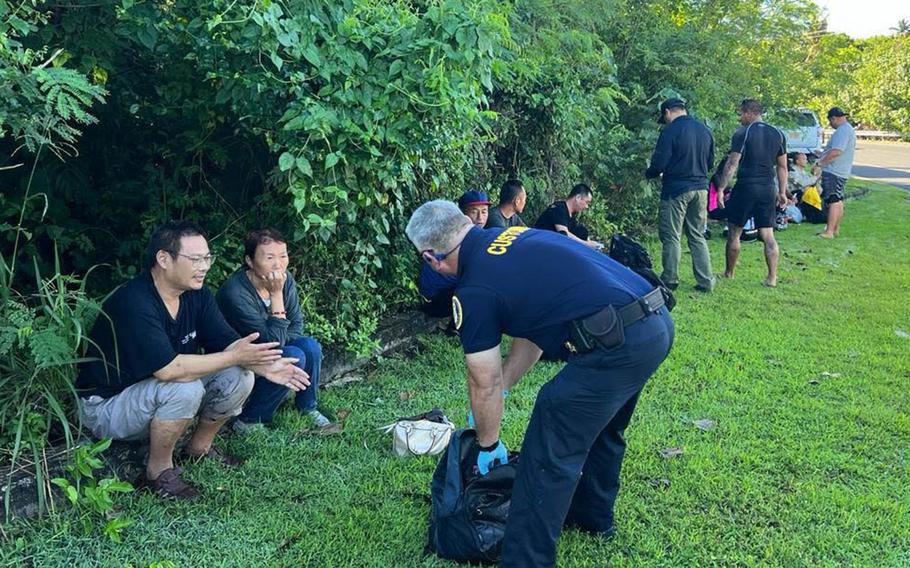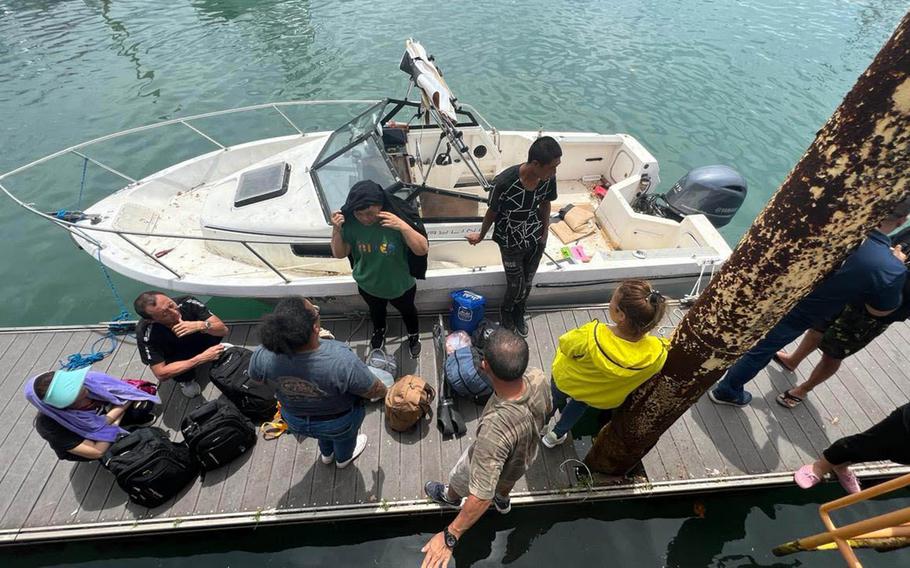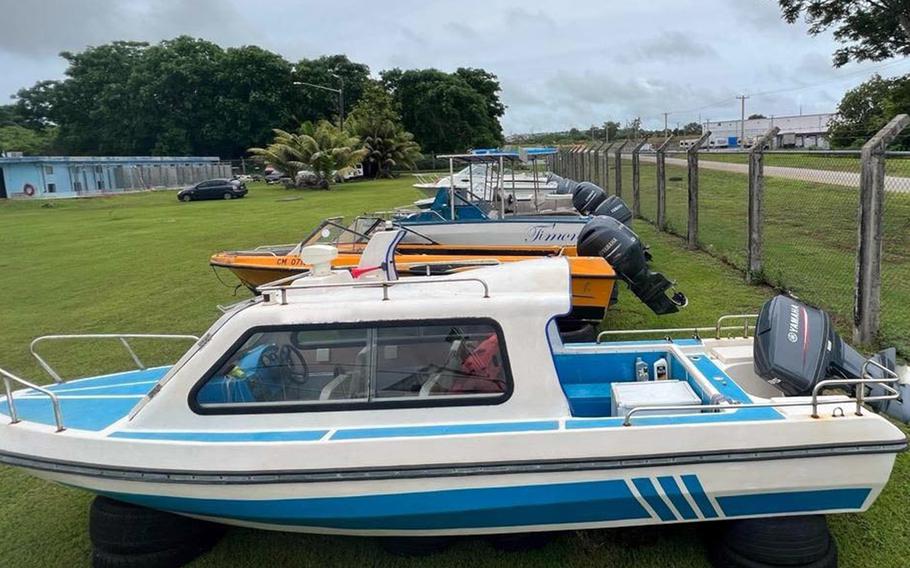
A Guam Customs and Quarantine agent speaks with Chinese nationals who allegedly tried to enter Guam illegally. (Guam Customs and Quarantine Agency)
In early January, U.S. Navy, Coast Guard and Guam first responders hurried to a distress call from a 23-foot recreational boat taking on water on the seas 30 miles northwest of the island.
Six Chinese citizens were lifted aboard a Navy helicopter and their boat was left to founder in six-foot waves.
The rescued boaters were among a stream of Chinese citizens coming from Saipan and intent on seeking asylum on Guam or entering illegally to find work, according to U.S. Homeland Security and Guam customs officials.
The lure for Chinese to make the trip is a no-visa policy that permits them to enter Saipan, part of the Northern Mariana Islands, a U.S. commonwealth separate from Guam, and stay up to two weeks.
For Guam, ending that waiver is mired in a jurisdictional web of territorial and federal law. Illegal immigration to Guam, while not the cascade typical of the U.S.-Mexican border, presents risks of intelligence gathering at U.S. bases on the island, drug smuggling and cheap, undocumented labor, said Guam Customs and Quarantine spokeswoman Alana Chargualaf-Afaisen.
Since 2022, the agency has reported 118 unlawful or attempted unlawful entries by Chinese citizens, she told Stars and Stripes by email last month.
Entries peaked in 2022 with 85 cases, followed by 27 in 2023 and six so far this year, Chargualaf-Afaisen said.
They come to Guam, a U.S. territory, seeking jobs, according to a Homeland Security agent, although the island’s first-term congressional delegate, Republican James Moylan, said he’s concerned about more sinister motivations.
These migrants could be involved in drug or human trafficking, cybersecurity breaches or threats to national security, Moylan said by email Monday.
“While we understand there are those who are entering the island to seek better opportunities for themselves and their families, when it comes to an ongoing migrant influx which has now spanned over a few years, there are certainly apprehensions when considering that bad actors could exist,” Moylan wrote.
He offered no examples of anyone arrested or charged with any of those offenses.

At least 118 Chinese nationals have entered or attempted to enter Guam illegally since 2022. (Guam Customs and Quarantine Agency)
‘Economic’ objectives
The Department of Homeland Security sees the situation as one motivated more by employment or asylum than espionage, said Special Agent in Charge John Tobon of Homeland Security Investigations in Honolulu.
“What we have found is that their primary objective really is economic,” he said by phone Feb. 2. “The one thing about all those individuals is that they are all vetted before they are admitted into Saipan.”
They are checked there against “a whole host of government databases” before being allowed to travel, Tobon added.
“Once they’re in Saipan, they may try to come over to Guam, but the overwhelming majority are really doing it for economic reasons,” he said.
Chinese citizens are eligible to enter Saipan through the visa waiver program implemented by the Department of Homeland Security in 2009, while other citizens of other countries can stay up to 45 days, according to the department’s website.
The program has been amended, at times allowing both Chinese and Russian citizens to enter Guam and the Northern Marianas. The waiver now applies only to Chinese citizens entering the Northern Marianas.
Homeland Security amended the program on Jan. 18 to require anyone using it to submit to an electronic travel authorization.
Previously, paper forms limited Customs and Border Protection’s “ability to implement an essential part of its national security strategy” and vet people before they travel, according to a Jan. 18 Homeland Security assessment of the waiver program.
“That may have a positive impact down the road, and should help us curb some of these issues,” Tobon said.
Once in Saipan, the commonwealth’s capital and largest island, many file for asylum, but they potentially face waits longer than nine years, said Col. Phil Taijeron, assistant chief for the Guam customs agency’s Special Enforcement Division.
Chinese workers often turned to construction, primarily at the struggling, shuttered multimillion-dollar Imperial Pacific Resort Hotel or casinos on the island, he said.
When construction work was disrupted by several typhoons, and the FBI raided the hotel’s casino, Chinese workers were left to “seek drastic measures,” Taijeron said.
Those measures included intentionally getting arrested, which may move them up in the asylum lines. Federal agencies are aware of this, Taijeron said, and find ways to return them to the Northern Marianas or seek other legal action.
“Their other pursuit is to go to Guam where construction employment is better than in the [Northern Marianas],” he said. “Hence why they pay $3,000 to $6,000 per person to get some boat operator to deliver them to Guam illegally.”

Customs authorities have seized more than a dozen small vessels associated with transporting Chinese nationals illegally to Guam since 2022. (Guam Customs and Quarantine Agency)
‘Too vital’
The problem is exacerbated by legal complexities unique to Guam and the Northern Marianas. Each have their own governments and governors, as well as government agencies, including customs.
“It’s not the same as if we encountered somebody that had just crossed the border from Mexico into the U.S.,” Tobon said.
Traveling from Saipan to Guam, from one territory to another, is not considered crossing an international border.
With separate customs agencies comes differing policies as well, Tobon added, which is why Chinese citizens can travel to Saipan but not Guam through the visa waiver program. Those nuances make actively addressing the situation via legislation or agency programs more complicated, he said.
Tobon and Taijeron said their respective agencies are working with everyone involved to address the problem.
Moylan said he hopes to speak with U.S. Immigration and Customs Enforcement and that Congress will address the situation.
“We are requesting for more resources and manpower,” he wrote. “Guam’s importance from a national security perspective is too vital not to take this illegal migration issues at our shores too lightly.”
But the complex nature of federal and territorial jurisdictions, for example, still poses problems, Tobon said.
“For the past 18 months, we’ve been working with Guam’s customs, [the Commonwealth of the Northern Marianas Islands], the Department of Public Safety, CNMI’s customs, the Coast Guard and the U.S. Attorney’s Office,” he said.
“It’s not straightforward at all.”